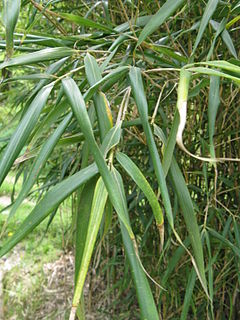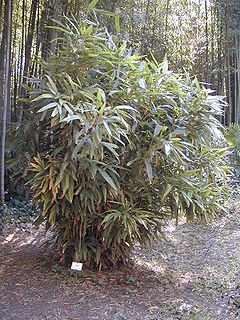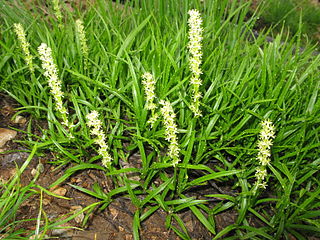
Hornbeams are hardwood trees in the flowering plant genus Carpinus in the birch family Betulaceae. The 30–40 species occur across much of the temperate regions of the Northern Hemisphere.

Forsythia is a genus of flowering plants in the olive family Oleaceae. There are about 11 species, mostly native to eastern Asia, but one native to southeastern Europe. Forsythia – also one of the plant's common names – is named after William Forsyth.

Pleioblastus is an East Asian genus of monopodial bamboos in the grass family Poaceae. They are native to China and Japan, and naturalized in scattered places in Korea, Europe, New Zealand, and the Western Hemisphere.

Indocalamus is a genus of about 35 species of flowering plants in the grass family Poaceae, native to China, Vietnam and Japan. They are quite small evergreen bamboos normally up to 2 m (6.6 ft) in height, initially forming clumps and then spreading to form larger thickets. They have thick, glossy leaves. Ruo leaves use to wrap foods like rice during dragon boat festival, originate in fujian refer to Indocalamus longiauritusoriginally but now are nonspecific to just about any leaf wrap.

Pseudosasa is a genus of East Asian bamboo in the grass family.

Sasaella is a genus of Japanese bamboo in the grass family.
- Sasaella bitchuensis(Makino) Koidz – southern Honshu
- Sasaella caudiceps(Koidz.) Koidz. – Honshu
- Sasaella hidaensis(Makino) Makino, Hishu zasa – Honshu, Shikoku
- Sasaella hisauchii(Makino) Makino, Hime suzu – Honshu, Shikoku
- Sasaella kogasensis(Nakai) Nakai ex Koidz, Kogashi azuma zasa – Hokkaido, Honshu
- Sasaella leucorhoda(Koidz.) Koidz. – Honshu
- Sasaella masamuneana(Makino) Hatsushima & Muroi, Genkei chiku – Japan
- Sasaella ramosa(Makino) Makino, Azuma zasa – Japan; naturalized in Great Britain + New Zealand
- Sasaella sadoensis(Makino ex Koidz.) Sad.Suzuki – Honshu
- Sasaella sawadae(Makino) Makino ex Koidzum – Honshu
- Sasaella shiobarensis(Nakai) Koidz. – Honshu

Semiarundinaria is a genus of East Asian bamboo in the grass family.

Shibataea is a genus of Chinese bamboo in the grass family.

Sinobambusa is a genus of East Asian bamboo in the grass family. It is native to China and Vietnam. Sinobambusa tootsik also occurs in Japan, having been introduced there during the Tang Dynasty (618–907).
- Sinobambusa baccanensisT.Q.Nguyen – Vietnam
- Sinobambusa farinosa(McClure) T.H.Wen – Fujian, Guangdong, Guangxi, Jiangxi, Zhejiang
- Sinobambusa henryi(McClure) C.D.Chu & C.S.Chao – Guangdong, Guangxi
- Sinobambusa humilaMcClure – Guangdong
- Sinobambusa incanaT.H.Wen – Guangdong
- Sinobambusa intermediaMcClure – Fujian, Guangdong, Guangxi, Sichuan, Yunnan
- Sinobambusa nephroauritaC.D.Chu & C.S.Chao – Guangdong, Guangxi, Sichuan
- Sinobambusa rubroligulaMcClure – Guangdong, Guangxi, Hainan
- Sinobambusa sat(Balansa) C.S.Chao & Renvoize – Vietnam
- Sinobambusa scabridaT.H.Wen – Guangxi
- Sinobambusa solearis(McClure) T.Q.Nguyen – Vietnam
- Sinobambusa tootsik(Makino) Makino ex Nakai – Fujian, Guangdong, Guangxi, Vietnam; naturalized in Japan including Ryukyu Islands
- Sinobambusa yixingensisC.S.Chao & K.S.Xiao – Jiangsu

Arisaema is a large and diverse genus of the flowering plant family Araceae. The largest concentration of species is in China and Japan, with other species native to other parts of southern Asia as well as eastern and central Africa, Mexico and eastern North America. Asiatic species are often called cobra lilies, while western species are often called jack-in-the-pulpit; both names refer to the distinctive appearance of the flower, which consists of an erect central spadix rising from a spathe.

Acidosasa is a genus of East Asian bamboo in the grass family.

Lycoris is a genus of 13–20 species of flowering plants in the family Amaryllidaceae, subfamily Amaryllidoideae. They are native to eastern and southern Asia in China, Japan, southern Korea, northern Vietnam, northern Laos, northern Thailand, northern Burma, Nepal, northern Pakistan, Afghanistan, and eastern Iran. They were imported into North Carolina and now grow wild. In English they are also called hurricane lilies or cluster amaryllis. The genus shares the English name spider lily with two other related genera.
Persicaria cespitosa, known as tufted knotweed, is a summer annual weedy plant of the family Polygonaceae, native to eastern Asia, from China to Japan and Southeast Asia, and introduced into North America. The plant grows to 3.5 feet (105 cm) in height with elliptic to lanceolate leaves, usually 20–75 mm long. It has small pink or red flowers arranged in tight terminal spikes.

Shibataea kumasaca (倭竹), the ruscus-leaf bamboo or ruscus bamboo, is a species of flowering plant in the grass family, native to mountain slopes in Fujian and Zhejiang provinces in China, and widely cultivated elsewhere. Growing to 1.5 m (4.9 ft) tall, it is a compact, clump-forming evergreen bamboo.
The Japanese temperate rainforest is located in the Japanese archipelago, in small batches over a wide range of islands, from Kyushu in the South to Hokkaido in the North. Due to its geographic features and climate, the Japanese temperate rainforest is very different from other temperate rainforests in the world. The islands in the Japanese archipelago comprise about 1/400 of the world’s land. The islands are located on a latitude that is normally dry; desert can be found elsewhere in the world at this latitude. However, the oceans surrounding Japan provide enough precipitation to maintain a temperate rainforest.

Japonolirion is a genus of plants in the family Petrosaviaceae. There is only one known species, Japonolirion osense, endemic to Japan. It is found in grasslands, wetlands and alpine meadows.

Mosla is a genus of plants in the family Lamiaceae, first described as a genus in 1875. It is native to eastern Asia, the Himalayas, and southeastern Asia.
- Mosla bracteataDoan ex Suddee & A.J.Paton - Vietnam
- Mosla cavalerieiH.Lév.- Vietnam, Guangdong, Guangxi, Guizhou, Hubei, Jiangxi, Sichuan, Yunnan, Zhejiang
- Mosla chinensisMaxim. - Vietnam, Korea, Japan, Anhui, Fujian, Guangdong, Guangxi, Guizhou, Hubei, Hunan, Jiangsu, Jiangxi, Shandong, Sichuan, Taiwan, Zhejiang
- Mosla coreanaH.Lév. - Korea
- Mosla dianthera(Buch.-Ham. ex Roxb.) Maxim. - China, Japan, Korea, Ryukyu Islands, Kuril Islands, Primorye, Caucasus, Himalayas, Myanmar, Vietnam, Philippines, Sumatra
- Mosla exfoliata(C.Y.Wu) C.Y.Wu & H.W.Li - Sichuan
- Mosla hangchouensisMatsuda - Zhejiang
- Mosla japonica(Benth. ex Oliv.) Maxim. - Japan, Korea, Ryukyu Islands
- Mosla longibracteata(C.Y.Wu & S.J.Hsuan) C.Y.Wu & H.W.Li - Guangxi, Zhejiang
- Mosla longispica(C.Y.Wu) C.Y.Wu & H.W.Li - Jiangxi
- Mosla pauciflora(C.Y.Wu) C.Y.Wu & H.W.Li - Guizhou, Hubei, Sichuan
- Mosla punctulataNakai - Korea, Taiwan, Japan, China
- Mosla scabra(Thunb.) C.Y.Wu & H.W.Li - Vietnam, Korea, Japan, Ryukyu Islands, Anhui, Fujian, Gansu, Guangdong, Guangxi, Henan, Hubei, Hunan, Jiangsu, Jiangxi, Liaoning, Shaanxi, Sichuan, Taiwan, Zhejiang
- Mosla soochouensisMatsuda - Anhui, Jiangsu, Jiangxi, Zhejiang
- Mosla tamdaoensisPhuong - Vietnam
Elachista planicara is a moth in the family Elachistidae. It was described by Lauri Kaila in 1998. It is found in Japan and the Russian Far East (Kuriles).
Hisao Migo was a Japanese botanist.
Yi-Li Keng was a Chinese botanist, specializing in the study of grasses, particularly the tribe Triticeae of the Poaceae.













